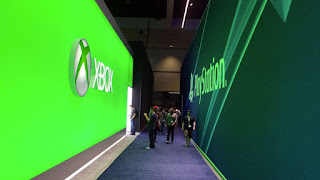It's 2019 and the Xbox Three has just been released.
You excitedly pack up your beloved Xbox Two and take it to your favorite local electronics store. Two hours later — after a hard drive transfer and a signed payment plan — you get home and fire up Halo 6 to see just how sharp it looks on the newly beefed up Three.
This scenario is obviously fiction, but getting a new gaming console for your home could look very similar in just a few years from now. That's our takeaway from the recent rumors coming out of Microsoft and Sony.
Consoles are typically relevant for around five years — sometimes longer — before something newer and shinier comes along to replace them. The older machines stick around, but game developers shift their attention to the more powerful hardware.
That's set to change if these rumors are accurate. Microsoft and Sony both are said to be introducing upgraded Xbox One and PlayStation 4 machines that support all the same games as the consoles released in 2013, but with enough added graphics and processing power to make everything run smoother and look better.
In addition, some of these reports indicate that the mid-generation upgrades are part of a larger shift for Microsoft and Sony, toward more regular console releases. Only instead of new machines replacing the old ones — the way things have always been — they'd just boost the performance for existing games.
If that sounds familiar, it's probably because most of us have a similar relationship with our smartphone providers. Each year, new phones and tablets surface to offer marginal performance increases. Some people flock to get the hot, new thing right away, others hold off and upgrade after two or three years.
Buying the latest iPhone or Galaxy outright costs hundreds and hundreds of dollars — in many cases it's north of $600, which is more than even a new console would cost. But wireless carriers chop up that cost into monthly installments, usually paid off over two years, so there isn't as much sticker shock.
After a certain period (typically 12 months), the customer can either continue paying off the cost of the phone in monthly installments or trade it in for a newer model. Of course, that restarts the installment plan, which continues, year after year, ad infinitum. The traded-in phones are repurposed, either as refurbished models or as spare parts.
Now, imagine a world where there are new Microsoft and Sony consoles released every one or two years.
Can you see yourself spending $600 on a machine that plays all the same games that your $600 machine from two years ago does? Sure, they look sharper and load faster, but most people aren't going to spend that kind of money on such a regular basis.
Right now, we're on the precipice of a new paradigm for console releases. But it's still got to make financial sense for the platform holders. If they're looking at fewer sales on a per-generation basis, how can they keep up a flow of income?
That's where, I think, a little bit of the mobile ideology around upgrades and installment plans will come into play. Microsoft and Sony can potentially "lease" out their hardware, in same way that the Verizons and AT&Ts of the world do. You pay a monthly fee over a period of time, until you either pay it off or return it and upgrade to the next one.
There's even a precedent for this in the video game industry.
Way back in 2012 — one year before the PS4 and Xbox One launched — Microsoft came up with a console subscription plan. For $99, plus another $15 per month over a two-year (minimum) period, you'd get an Xbox 360, a Kinect and an Xbox Live Gold subscription.
It wasn't a huge success for a number of reasons. First: the Xbox 360's days were numbered by 2012. By then, most were counting the days until the new consoles launched. Not many were willing to commit to two years with a console that might be yesterday's news in one.
What's more, it wasn't a very good deal. Buying that whole package up front at the time would have cost around $390. A full two-year contract, on the other hand, would have totaled out at $460.
Smartphone upgrade plans make sense for consumers because they save you money, in a sense. A one-year upgrade plan commits you to paying the monthly rate for 18 months, or upgrading after 12. The remaining six months are wiped away because you return the phone, which still has value.
That's going to be the key for getting subsidized hardware contracts to make sense. Gamers that upgrade to a new console — one that supports all the same software — have no further need for their older hardware. So why not let them swap old for new, and let the value of the older hardware offset what you spend to upgrade?
Personally, I think Microsoft's subsidized Xbox 360s were meant to be a test case. It was a noteworthy idea that made no reasonable sense at such a late moment in the console cycle... except as a proof-of-concept.
There are lots of questions to be answered in the run-up to E3. The Neo and/or Scorpio might not be announced this year; hell, they might not even be real (though they probably are). I toss out this idea of subsidized upgrades because — based on past events plus what we know, or think we know, right now — it's the only thing that makes sense.
Have something to add to this story? Share it in the comments.


No comments:
Post a Comment